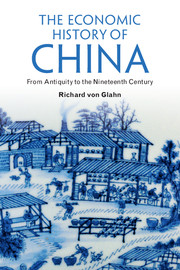Book contents
- Frontmatter
- Dedication
- Contents
- List of figures
- List of maps
- List of tables
- Acknowledgments
- Introduction
- 1 The Bronze Age economy (1045 to 707 BCE)
- 2 From city-state to autocratic monarchy (707 to 250 BCE)
- 3 Economic foundations of the universal empire (250 to 81 BCE)
- 4 Magnate society and the estate economy (81 BCE to 485 CE)
- 5 The Chinese-nomad synthesis and the reunification of the empire (485 to 755)
- 6 Economic transformation in the Tang-Song transition (755 to 1127)
- 7 The heyday of the Jiangnan economy (1127 to 1550)
- 8 The maturation of the market economy (1550 to 1800)
- 9 Domestic crises and global challenges: restructuring the imperial economy (1800 to 1900)
- Bibliography
- Index
6 - Economic transformation in the Tang-Song transition (755 to 1127)
Published online by Cambridge University Press: 05 March 2016
- Frontmatter
- Dedication
- Contents
- List of figures
- List of maps
- List of tables
- Acknowledgments
- Introduction
- 1 The Bronze Age economy (1045 to 707 BCE)
- 2 From city-state to autocratic monarchy (707 to 250 BCE)
- 3 Economic foundations of the universal empire (250 to 81 BCE)
- 4 Magnate society and the estate economy (81 BCE to 485 CE)
- 5 The Chinese-nomad synthesis and the reunification of the empire (485 to 755)
- 6 Economic transformation in the Tang-Song transition (755 to 1127)
- 7 The heyday of the Jiangnan economy (1127 to 1550)
- 8 The maturation of the market economy (1550 to 1800)
- 9 Domestic crises and global challenges: restructuring the imperial economy (1800 to 1900)
- Bibliography
- Index
Summary
The outbreak in 755 of the An Lushan rebellion, led by a disgruntled frontier general of Sogdian descent who turned against the imperial court, dealt a shattering blow to the Tang dynasty. The reigning emperor was forced to flee Chang'an, which was seized by An Lushan in 756 and later sacked by a marauding Tibetan army, and seek refuge in the southwest. By the time the rebellion was quelled in 763 the rich agricultural heartland of the Central Plain lay in ruins and hundreds of thousands had perished. The Tang was restored to power only through the crucial support of Uighur mercenaries and by ceding effective control of most of the northern provinces to regional warlords. The Tang polity emerged from the rebellion only a shadow of its former self, its basic institutions irreparably broken.
The period from 750 to 1250, which scholars commonly refer to as the “Tang-Song transition,” is widely recognized as the crucial watershed in the economic history of imperial China. Over the course of this period the rice economy of the Yangzi River valley supplanted the traditional heartland of the Central Plain as the Chinese economy's center of gravity. The shift of population from north to south inaugurated a series of profound transformations in agricultural productivity, technology, industrial growth, transport, finance, and international trade. Sustained economic growth fueled unprecedented demographic expansion. By 1100 the empire's population reached 100 million, far surpassing the peak levels (roughly 60 million) of the Han and Tang. The new foundations of the Chinese economy laid during the Tang-Song transition would endure throughout the rest of China's imperial era.
The extraordinary sweep of economic change during the Tang-Song transition bespoke fundamental institutional transformations. Following the collapse of the equal-field system, private ownership of land became the rule. Progressive taxation based on household assets of villagers and towndwellers alike replaced the principle of uniform taxation that underlay the Tang zu-yong-diao tax regime. The abolition of statutory labor obligations for most of the population and the long-term decline in personal bondage eliminated key constraints on the allocation of household labor. The steady trend toward monetization of taxation – and the sharply reduced scale of tax payments in cloth in particular – likewise allowed households greater freedom to invest their labor and resources as they saw fit.
- Type
- Chapter
- Information
- The Economic History of ChinaFrom Antiquity to the Nineteenth Century, pp. 208 - 254Publisher: Cambridge University PressPrint publication year: 2016



